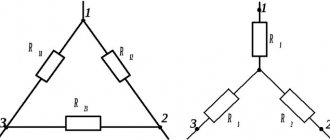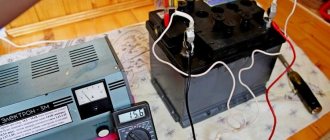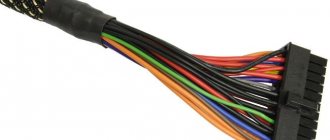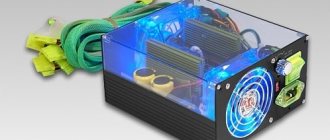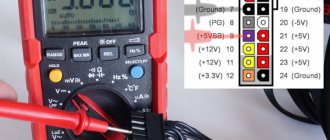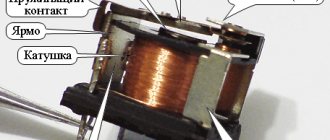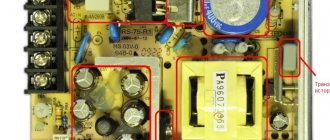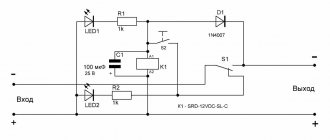It happens that you need to pump up the tires on a car in the garage, for example, or pump up the wheels when replacing them (summer-winter), or even pump them up on a bicycle) For adequate operation of the compressor, you need to start the car. You don’t have to start it, but the power is not the same, and you don’t want to load the battery... I decided to hook up the power supply for the compressor. Any 12 volt units with a current strength of up to 2A inclusive are not 100% tested! The compressor sucks out all the current instantly! and it works for 0.2 seconds, then 0.5 seconds silence, then 0.2 seconds it works, 0.5 silence... Having looked at how many amperes the power supply from the computer produces at 12 volts - 40A or more, I decided to assemble such a unit from it. This is what happened:
There is a video of how it all works:
I use the unit once a month for sure!
I took a 350W power supply from a used computer which was basically just written off) The only cost on my part was time and effort)
simply and in detail about a personal computer, its structure, configuration and assembly.
Thursday, August 2, 2012
Power supply for computer
Main characteristics of modern power supplies:
The most common power supplies for desktop computers are of the ATX form factor with an additional 12-volt power connector and have standard dimensions of 150x86x140 mm. They are strictly followed by all manufacturers, so you can easily change one power supply to another. However, high-power models, as a rule, have non-standard, increased dimensions, which is caused by the need to install two power transformers capable of delivering the required power. We are talking about power supplies with a power of 1000 W and higher - they are approximately 40-50 mm longer than standard ones.
At the output, the power supply produces the following voltages: +3.3 v, +5 v, +12 v and some auxiliary -12 v and + 5 VSB. The main load falls on the +12 V line. Power (W - Watt) is calculated by the formula P = U x I, where U is the voltage (V - Volts), and I is the current strength (A - Ampere). Hence the conclusion, the greater the current along each line, the greater the power. But not everything is so simple, for example, with a heavy load on the combined line +3.3 v and +5 v, the power on the +12 v line may decrease. Let's look at an example based on the labeling of the AEROCOOL E85-700 power supply.
It is indicated that the maximum total power on the +3.3V and +5V lines = 150W, and it is also indicated that the maximum power on the +12V line = 648W. Please note that two virtual lines +12V1 and +12V2 of 30 Amps each are indicated - this does not mean that the total current is 60A, since with a current of 60A and a voltage of 12V, the power would be 720W (12×60=720). In fact, the maximum possible current on each line is indicated. The real maximum current can be easily calculated using the formula I=P/U, I = 648 / 12 = 30 Ampere. Total power 700W.
To calculate the power of the power supply, you can use this calculator, the service is in English, but I think you can figure it out. From my own experience, I can note that a 350W power supply is quite sufficient for an office computer. For a gaming one, a 400-500W power supply is enough; for the most powerful gaming ones with a powerful video card or two in SLI or Crossfire mode, a 600-700W unit is needed. The processor usually consumes from 35 to 135W, video card from 30 to 340W, motherboard 30-40W, 1 memory stick 3-5W, hard drive 10-20W. Also keep in mind that the main load falls on the 12V line. Yes, and don’t forget to add a margin of 20-30% for the future.
The efficiency of the power supply will not be unimportant. Efficiency (coefficient of performance) is the ratio of output power to consumed power. If the power supply could convert electrical energy without loss, then its efficiency would be 100%, but this is not yet possible. For example, in order for a power supply with an efficiency of 80% to provide an output power of 400W, it must consume no more than 500W from the network. The same power supply, but with 70% efficiency, will consume about 571W. Again, if the power supply is not heavily loaded, for example at 200W, then it will also consume less from the network, 250W at 80% efficiency and approximately 286 at 70% efficiency. There is an organization that tests power supplies to meet a certain level of certification. The 80 Plus certification was carried out only for the 115V electrical network common, for example in the USA. Starting from level 80 Plus Bronze, power supplies are tested for use in a 230V power supply. For example, to achieve Level 80 Plus Bronze certification, the power supply efficiency must be 81% at 20% load, 85% at 50% load, and 81% at 100% load.
How to connect multimeter wires
After a purchase, many beginners often have a question: where to insert the wires (to be precise, they are called probes
) multimeter and how to do it correctly.
Most multimeters have three wire connectors and two wires - black and red. Black
the wire is inserted into the socket labeled
COM
,
the red
wire is inserted into the socket where the symbols include the
designation V.
The third socket is used to measure high currents and we don’t need it to measure voltage; in general, if necessary, the red wire is plugged into it, and the black one always remains in one socket.
Checking the battery with a multimeter
The test must only be carried out under load. It is impossible to check how many amperes there are in a battery with a multimeter only using the internal capacity of the battery due to its small size - the obtained indicators will not reflect the true numbers.
The tester can measure not only the operating current, but also the battery leakage current. Before checking with a multimeter how many amperes the leakage current is, you must remember that it can reach up to several amperes. Therefore, you need to set the measurement limits on the device correctly, preferably up to 10 A.
In practice, before checking the amperes on the battery with a multimeter, you should remove the positive wire from the battery and connect a measuring device to the resulting gap. After this you need:
- select the mode for measuring current on the multimeter;
- secure the wires with crocodile clips and one by one remove the fuses that are responsible for the electronic module in the car.
With some practice, you will not only know how to test amps with a multimeter, but you will also be able to easily detect the causes of leakage without calling a service center.
How to measure the voltage in an outlet
One of the most common tasks is measuring the voltage in an outlet.
or in apartment wiring.
This is very easy to do with a multimeter. As we wrote above, alternating current flows in sockets, so to measure it you need to set the switch on the multimeter to the ACV
.
We know that the voltage should be approximately 220 volts, so if you have a multimeter like the example in the photo above, set the switch to a mark higher than the expected value
, in this case at
750
in the ACV range.
Having set up the device, it’s time to put your probe fingers into the socket. It makes no difference which wire is inserted into which hole in the socket. In general, there is nothing to be afraid of here, the main thing is to hold on to the insulated part of the probes and not touch their metal part (although this is quite difficult to do even with a strong desire), and also not to allow them to touch each other while they are inserted into the socket, otherwise you can cause a short circuit .
If you did everything correctly, the screen of your multimeter will show the current voltage in the outlet and your indoor wiring.
In our case, this is 235.8 volts - within normal limits. You will never see exactly 220V on the screen, so an error of +-20 is normal.
How to find Power if you know the voltage and current?
Power is numerically equal to the product of the current flowing through the load and the voltage applied to it. To convert Watts to Amps, you will need the formula: I = P / U, where I is the current strength in amperes; P – power in watts; U – voltage in volts.
Interesting materials:
When is Angel Eve Day? When is Darina's angel day? When is Olga's Angel Day 2022? When is Vitaly Angel Day 2022? When is Bank Worker's Day 2022? When is Daughters Day 2022? When is DPR Flag Day? When is Olga's name day? When is Marina Day 2022? When is Alexander's Day 2022?
DC current measurement
, you first need to determine what type of current flows in the circuit being tested. This depends on the power source of the circuit. For example, batteries and rechargeable batteries are constant sources of power. To measure DC current, you need to set the rotary knob of the multimeter to the A -, DCA or I - icon, or press the button on the front panel corresponding to the desired mode. Both alternating and direct current are measured in amperes. Therefore, the value on the meter screen will be displayed in this value.
Voltage determination
DC and AC voltage values can also be found using a multimeter. To do this you need:
A multimeter is an indispensable device for effectively working with electrical circuits and signals. Using such a device, you can quickly identify a malfunction and determine the necessary signal parameters, so it is important to always have it on hand.
A multimeter is a device for measuring various electrical parameters. It allows you to measure direct and alternating voltage, current, resistance, as well as many specific parameters, such as the performance of diodes, transistors, and signal frequency. In order to know how to measure current with a multimeter, you need to understand the basic principles of operation of this device.
Safety precautions
It's easy to check the current strength. It is enough to connect the multimeter in accordance with the operating rules. It is necessary to follow the instructions in order not to violate safety precautions:
- The device is connected in a de-energized state.
- Pre-inspect the insulation on the wires. With a long service life, its integrity is compromised. There is a possibility of receiving an electric shock.
- You only need to measure amperes while wearing rubber gloves.
- Measurements are prohibited in rooms with high humidity. Moisture has high electrical conductivity. The risk of injury increases several times.
- Anyone who has suffered an electric shock, regardless of its power, must be urgently taken to the nearest medical center. It is forbidden to work with electricity alone. In an emergency, your partner can call an ambulance.
- It is strictly forbidden to work with devices that spark or are broken when connected to analog power sources, for example, to a battery, batteries or power supply. All this can lead to electric shock. Not too strong, but capable of harming the human nervous system and heart.
- It is forbidden to use a multimeter after an impact, just as it is forbidden to glue it with tape or insulating tape. It is better to use a new device or entrust it to a specialist for repair and testing for suitability.
After using the multimeter device, the cables that were cut are connected with the circuit de-energized.
Damage is corrected with electrical tape
A multimeter is a device that is simply impossible to do without in everyday life and other areas. Having even the most minimal knowledge of its operation, you can repair the devices. Knowing the indications, it is easy to determine their unsuitability.
Source
How to Measure Battery or Battery Voltage
All kinds of batteries and various accumulators, in general, everything where you see “+” and “-” are all sources of direct electric current. Measuring DC voltage is no more difficult than alternating voltage.
To do this, take, for example, the most ordinary AA battery. Connect red
The multimeter wire with
“+”
is the outer contact of the battery, and
the black one
with
“-” is the outer one
. If you connect them the other way around, nothing bad will happen, the readings will simply be displayed on the multimeter screen with a minus sign, something like this.
Usually the voltage on the batteries is low, so you don’t have to be afraid to press the probes with your fingers. Up to 20 volts you most likely won't feel anything. In the case of an AAA battery, its maximum voltage is 1.5 volts, which is not at all dangerous for a person.
As we can see from the multimeter readings, the voltage in our battery is 1.351 volts, which means the battery is still fully charged and can be used.
In a similar way, you can check any other batteries and measure their voltage, and as you now know, there is nothing complicated about it.
If computer malfunctions occur, system diagnostics are required. One of the first to be tested is the power supply. Therefore, it is important for an active user to know how to check the power supply.
Thursday, August 2, 2012
Power supply for computer
Main characteristics of modern power supplies:
The most common power supplies for desktop computers are of the ATX form factor with an additional 12-volt power connector and have standard dimensions of 150x86x140 mm. They are strictly followed by all manufacturers, so you can easily change one power supply to another. However, high-power models, as a rule, have non-standard, increased dimensions, which is caused by the need to install two power transformers capable of delivering the required power. We are talking about power supplies with a power of 1000 W and higher - they are approximately 40-50 mm longer than standard ones.
At the output, the power supply produces the following voltages: +3.3 v, +5 v, +12 v and some auxiliary -12 v and + 5 VSB. The main load falls on the +12 V line. Power (W - Watt) is calculated by the formula P = U x I, where U is the voltage (V - Volts), and I is the current strength (A - Ampere). Hence the conclusion, the greater the current along each line, the greater the power. But not everything is so simple, for example, with a heavy load on the combined line +3.3 v and +5 v, the power on the +12 v line may decrease. Let's look at an example based on the labeling of the AEROCOOL E85-700 power supply.
It is indicated that the maximum total power on the +3.3V and +5V lines = 150W, and it is also indicated that the maximum power on the +12V line = 648W. Please note that two virtual lines +12V1 and +12V2 of 30 Amps each are indicated - this does not mean that the total current is 60A, since with a current of 60A and a voltage of 12V, the power would be 720W (12×60=720). In fact, the maximum possible current on each line is indicated. The real maximum current can be easily calculated using the formula I=P/U, I = 648 / 12 = 30 Ampere. Total power 700W.
To calculate the power of the power supply, you can use this calculator, the service is in English, but I think you can figure it out. From my own experience, I can note that a 350W power supply is quite sufficient for an office computer. For a gaming one, a 400-500W power supply is enough; for the most powerful gaming ones with a powerful video card or two in SLI or Crossfire mode, a 600-700W unit is needed. The processor usually consumes from 35 to 135W, video card from 30 to 340W, motherboard 30-40W, 1 memory stick 3-5W, hard drive 10-20W. Also keep in mind that the main load falls on the 12V line. Yes, and don’t forget to add a margin of 20-30% for the future.
The efficiency of the power supply will not be unimportant. Efficiency (coefficient of performance) is the ratio of output power to consumed power. If the power supply could convert electrical energy without loss, then its efficiency would be 100%, but this is not yet possible. For example, in order for a power supply with an efficiency of 80% to provide an output power of 400W, it must consume no more than 500W from the network. The same power supply, but with 70% efficiency, will consume about 571W. Again, if the power supply is not heavily loaded, for example at 200W, then it will also consume less from the network, 250W at 80% efficiency and approximately 286 at 70% efficiency. There is an organization that tests power supplies to meet a certain level of certification. The 80 Plus certification was carried out only for the 115V electrical network common, for example in the USA. Starting from level 80 Plus Bronze, power supplies are tested for use in a 230V power supply. For example, to achieve Level 80 Plus Bronze certification, the power supply efficiency must be 81% at 20% load, 85% at 50% load, and 81% at 100% load.
The presence of one of the logos on the power supply indicates that the power supply meets a certain level of certification. Advantages of a power supply with high efficiency: Firstly, less energy is released in the form of heat; accordingly, the cooling system of the power supply needs to remove less heat, therefore, there is less noise from the fan. Secondly, small savings on electricity. Thirdly, the quality of the BP data is high.
